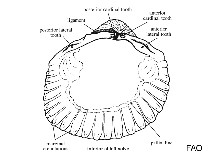Fulvia hungerfordi (Sowerby, 1901)
| Native range | All suitable habitat | Point map | Year 2050 |

|
| This map was computer-generated and has not yet been reviewed. |
| Fulvia hungerfordi AquaMaps Data sources: GBIF OBIS |
Google image | No image available for this species;
drawing shows typical species in Cardiidae.
Classification / Names Κοινά ονόματα | Συνώνυμα | CoL | ITIS | WoRMS
Bivalvia | Cardiida | Cardiidae
Environment: milieu / climate zone / εύρος βάθους / distribution range Οικολογία
; εύρος βάθους 0 - 45 m (Αναφ. 75831), usually 10 - ? m (Αναφ. 104607). Tropical
Distribution Χώρες | Περιοχές FAO | Οικοσυστήματα | Παρουσίες | Εισαγωγές
Indo-Pacific.
Length at first maturity / Μέγεθος / Weight / Age
Γεννητική Ωρίμανση: Lm ? range ? - ? cm
Life cycle and mating behavior Γεννητική Ωρίμανση | Αναπαραγωγή | Γεννοβολία | Eggs | Γονιμότητα | Larvae
Main reference
Αναφορές | Συντονιστής | Συνεργάτες
Leung, K.F. and B. Morton 2000 The 1998 resurvey of the subtidal molluscan community of the southeastern waters of Hong Kong, six years after dredging began and three since it ended. pp. 553-617 In B. Morton (ed.) The Marine Flora and Fauna of Hong Kong and Southern China V, Proceedings of the Tenth International Marine Biological Workshop, Hong Kong, 6-26 April 1998. Hong Kong University Press. (Αναφ. 77724)
IUCN Red List Status
(Αναφ. 130435: Version 2025-1)
CITES status (Αναφ. 108899)
CMS (Αναφ. 116361)
Threat to humans
Human uses
| FishSource |
Εργαλεία
Περισσότερες πληροφορίες
Σύσταση δίαιτας
Κατανάλωση τροφής
Θηρευτές
Διαδικτυακές πηγές
BHL | BOLD Systems | CISTI | DiscoverLife | FAO(Publication : search) | Fishipedia | GenBank (genome, nucleotide) | GloBI | Gomexsi | Google Books | Google Scholar | Google | PubMed | Δέντρο Ζωής | Wikipedia (Go, αναζήτηση) | Zoological Record



